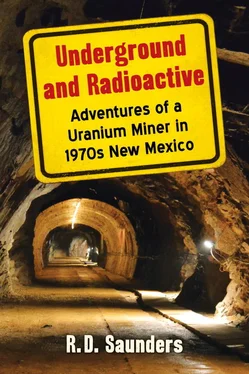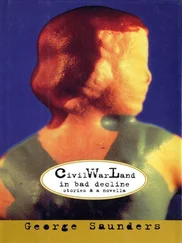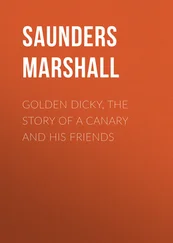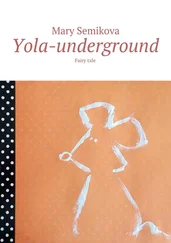With Anthony standing a few feet off to my left, I let the drill roar to life. Once again real production mining had returned to the 502.
With the machine going full speed, I stood there in the rejuvenated 502 with one hand on the throttle and let my mind wander back to the weekend. Most other days I would have been more aware of what was happening in the stope and might have seen the wall of sand that had been vibrated loose and was cascading toward me. But not that day.
The huge wall of sand to my right broke free along with that three-foot section of square-set post. Somehow I was not buried by the sand but was hit squarely in the back by the waterlogged chunk.
Getting hit hurt, and I knew in an instant that even if I didn’t get buried by the sand, I wouldn’t be getting up and walking out of this one. It was no little slab from which I stood up wondering what had happened. Oh no, this was something much more.
The rush of sand stopped, and I was left lying on top of it, miraculously saved from burial within. I lay there in agonizing pain, having great difficulty breathing, gasping for air.
Anthony Gonzalez, while grazed by the wall of sand, had managed to escape the worst of it by dashing toward the manway. When the sand stopped falling in, he had come running over to where I lay. He might have wished he hadn’t.
I grabbed his arm and put a death grip on it that had to have hurt, and I wouldn’t let go. It wasn’t that he didn’t try to leave to find help, because he did, but I wasn’t letting him go anywhere.
Several minutes passed, and I was still having some difficulty breathing and still squeezing Anthony’s arm for all I was worth. Then, slowly, I began to recover my breath.
As I experienced intense pain, it dawned on me that assistance was needed. It was then that I loosened my grip on Anthony. When I did so he was gone in a flash, down the manway on the way for help.
Section 35 had a rescue team that was fast, professional and serious. The guys I had come into contact with who worked rescue seemed to rarely smile, perhaps because they had seen too much or perhaps because so many depended on them. I had seen this team in action and knew that once Anthony let them know where I was, it wouldn’t be long until they reached me.
Because the 502 was a relatively short distance to the station, it must have taken Anthony no longer than five minutes to reach a shift boss or a telephone. In approximately ten minutes, the rescue team arrived. Not knowing which would be needed, they brought along a rescue board used to transport miners suspected of sustaining a back or neck injury and a basket used for those having suffered, for example, a broken or missing limb.
The man leading the rescue team was James Baca, one of the premier miners at Section 35. He did jobs nobody else could do or would do, and he volunteered for both. He was making around $300 an hour from what I saw on the miner’s contract board, and while I didn’t know exactly what he did to earn that kind of money, I knew he must have been very good at whatever it was.
I didn’t know James Baca, so here we were meeting for the first time, with me lying there doing all I could not to scream out in agony and him trying to get me to the surface as quickly as possible. I was reassured when James told me it wouldn’t be long before they got me out of there.
I was in a tough spot, knowing I couldn’t get up and save myself, knowing I had to rely on others for that. Fortunately, I could move around a little, and everything on my body seemed to be working, but there was definitely something wrong with my back.
Having ascertained the type of injury they were dealing with, the rescue crew took great care in lifting me onto the stretcher board, strapping me in and tying me down so that even had I wanted to move, it became impossible. Four members of the crew then picked me up and headed off toward the only way down to track level, the manway.
When we reached the manway, there was some discussion among the rescue crew as to how exactly I was to be lowered. It was finally agreed to attach the stretcher to the winch used to lift supplies and slowly lower me that way. There wouldn’t be anyone with me on this trip, and it would be a slow one.
Fortunately, the manway was only about twenty-five feet down to track level, so while it was a slow trip, it was also a short one.
A few more of the rescue crew were waiting at the bottom of the manway, and when I arrived they carefully removed me, and we all headed to the station at the quickest pace they could manage.
When we reached the station, the cage was waiting, and up we went. I estimate that from the time of the accident to reaching the surface could not have been much more than twenty minutes, if that. I have always been grateful to the rescue personnel, themselves miners, who acted with such urgency and took such great care to get me out of there.
Now I was lying there in the Dry staring up at the curious faces. Thankfully Shotgun had everyone get back to what they were doing, and I was lying there alone, waiting for the ambulance.
Before long the ambulance arrived, and I was loaded up and ready for the very long ride to the Grants Clinic.
The diagnosis was a broken vertebra. I spent two weeks at the Grants Clinic, and while it wasn’t pleasant overall, there were some enjoyable elements. One was Demerol.
At first the injections were urgently anticipated to ease the pain, and later I wanted one whether I needed it or not. My physician, Dr. Valdivia, was good and realized what patients like me were up to, so the administration of Demerol by needle tapered off and was replaced with a pill form of the drug that, while decent, couldn’t match the rush of the injections. I now have at least some rudimentary understanding of drug addiction. That Demerol was good stuff.
I signed some papers and cashed some checks during the period of Demerol injections that I later had no recollection of. I ended up getting copies of the checks I signed before I would believe I had actually done it. That’s what drugs will do to you.
As for the injury itself, I never lost the use of any extremity, but I did lose feeling in several spots on my body that ranged from a square inch to one area of the chest that was several inches around. I would pinch these areas and feel nothing for many months afterward.
Although my injury did not feel minor, during my stay at the clinic I met other miners with injuries far more severe than mine. I quickly realized the good fortune with which I had been blessed to have had such relatively modest damage.
The Grants Clinic. that also served as the only hospital in town, was filled with underground workers who had been hurt in some particularly gruesome ways. One of my roommates had been routinely operating a slusher when the drum bearings came apart, sending a bolt through his ankle, irreparably destroying his bones.
Another laborer had been walking down a main track drift when he was struck by the lead ore car of a motor. He told me he never saw or heard it coming. He lived to talk about it, but he was pretty broken up. My discomfort paled by comparison to these men, and I resolved to tone down my internal self-pity a little.
My hospital stay lasted for two weeks, after which I was fitted with a waist-to-neck body cast and sent home.
At some point during my stay at the Grants Clinic, Greg Hornaday left without a word. I never figured that one out. He just up and vanished, never to be seen again.
Someone stole the battery out of my El Camino during my clinic stay, adding insult to injury, so I had to get that replaced just to get home.
The cast stayed on for three months, during which time it was somewhat difficult to get around or do much of anything. Occasionally I would take a drive, but had I suffered a flat tire, I would have been unable to change it, so I never ventured far from home.
Читать дальше












